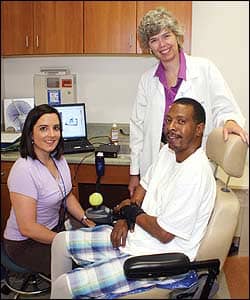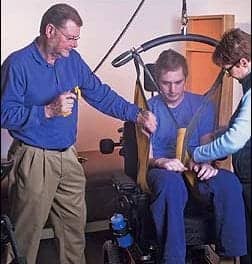 |
| Author Margaret Kitterman Blagg, PT, DPT (left); patient Gary Lynch; and Pamela Salazar, MD, in the Walton Rehabilitation Health System Wheelchair Seating and Equipment Clinic. |
Pressure ulcers, also known as pressure sores, bed sores, decubiti, and skin breakdown, are very common in people who are wheelchair- or bed-bound.1 In fact, it has been estimated that anywhere from 1.3 to 3 million adults develop pressure ulcers each year2 and that 85% of patients with a spinal cord injury develop at least one pressure ulcer at some point in their lives.3 Ulcers usually occur because of continuous pressure over bony prominences, resulting in decreased blood supply, nutrients, and lymphatic drainage to and from the tissues. They can occur within a few hours of immobility.
The most common form of pressure ulcer classification is a grading scale starting at Stage I—intact skin with persistent changes in color, temperature, skin consistency, and sensation—through Stage IV—full thickness tissue destruction. External factors that place a person at a higher risk of developing skin breakdown—pressure, friction, shearing, and maceration—are highly related to the intrinsic factors of decreased sensation, decreased mobility, altered circulation, and incontinence.4 The cost of healing existing pressure ulcers is staggering. Lyder estimated in 2003 that the estimated cost of healing is $500 to $40,000 per ulcer.2 The actual cost differs according to the size and stage of the ulcer.
The technology of adaptive equipment today, along with patient education and a strong team approach between doctors, nurses, therapists, assistive technology professionals, and of course the patient, can help lower a patient’s risk of developing pressure ulcers. Depending on the severity or level of a person’s injury, high external pressures may go unnoticed. Think about how much you shift and move around for comfort after sitting for long periods of time. Think about how much you move around at night while you are sleeping. All of these movements act as different techniques to relieve pressure. When a person’s neuromuscular system is not intact, they may lack the ability to perform adequate weight shifts or pressure reliefs. Diminished or absent sensation prohibits the person from feeling the discomfort or pain associated with increased pressure and the need for a position change.
One way to decrease the amount of interface pressure between the patient and the chair is to use different materials in wheelchair cushions and mattresses. Cushions are made from an assortment of materials that provide varying amounts of pressure reduction and stability. As a general rule, the softer, more pliable materials provide better pressure reduction but decreased stability, while the firmer surfaces provide better stability. Materials range from foams and gels of varying densities to viscoelastic materials and air, as well as combinations of these materials that best meet each patient’s pressure and stability needs. Materials can also be shaped and custom-molded to the patient for increased contact. This helps to disperse pressure over a larger surface area and prevent areas of higher density, much in the same way someone can lie on a bed of nails without his skin being pierced. Working with an assistive technology professional to change the angles of the wheelchair allows the health care team to use the patient’s shape to provide the most pressure reduction. It is important that each individual’s needs are assessed by the health care team.
TISSUE BREAKDOWN, SHEARING, AND MACERATION
Skin breakdown is affected by other extrinsic factors besides external pressure. Friction occurs when a person’s skin rubs against another surface, causing tearing of the tissues such as when a person drags their hips during transfers or when caregivers pull a patient across sheets. Education regarding transfer techniques plays a key role in preventing skin breakdown from friction.
Shearing is when two forces move in opposite directions. This type of breakdown can occur when a wheelchair or bed is reclined because the back of the chair or bed is essentially sliding up and the body is sliding down. Shearing occurs mostly in patients who are bed-bound and utilize the reclining feature of hospital beds. It can be avoided by taking care not to elevate the head of the bed more than 30º and by using pillows and foam wedges to assist with maintaining proper positioning.
Maceration is the softening of the skin that occurs when tissues become waterlogged because of excessive moisture from sweating, incontinence, or other liquids. It makes the skin weaker and more susceptible to tearing. Not only have technological advances been made in cushion materials, but there are also new materials that cover these cushions. These materials have two purposes—protecting the cushion to preserve its integrity and pressure-relieving ability as well as protecting the patient’s skin from moisture. Materials can provide a waterproof barrier for the cushion and can also wick moisture away from the skin. Some cushion covers are designed with several layers of materials that are separated to allow for increased air flow next to the skin. The best option is to avoid letting a patient sit in a moist environment for long periods of time. Education regarding bowel and bladder programs, regular skin checks, and immediate cleaning and drying of the patient, clothing, and equipment all help to decrease this risk factor.
There are several techniques for detecting pressure and risk of skin breakdown for a wheelchair- or bed-bound individual. The most advanced method of indicating pressure points is by using pressure mapping, which utilizes a mat of pressure-sensitive cells that relay pressure gradients in millimeters of mercury to a computer output. When reading a mapping output, a schematic of lower numbers and cool colors is ideal. However, it is more important that pressure is evenly dispersed without any areas of high-density pressure. The mat itself is transportable and can be used in the wheelchair seat or back, in cars, on beds, or on any other surface.
PRESSURE MAPPING, ADJUSTMENTS, AND CUSTOM SEATING
Pressure mapping is used as a tool to assess the effectiveness of cushions and wheelchair adjustments in relieving pressure. It also can be used as a treatment tool in educating patients about performing pressure reliefs and equal weight bearing. The mapping system and computer output are used as real-time visual feedback to assist patients in determining the most effective pressure relief technique as well as emphasize the importance of regular weight shifts. It is also important to note that if increased pressure is suspected, mapping can provide objective data to insurance companies regarding the increased risk of skin breakdown to support the use of more expensive pressure-relieving cushions.
Customized back and cushion molding systems are also being made with built-in pressure mapping to make even more effective seating systems. In addition to mapping, the health care team can assess the fit of a seating system by feeling how much contact is between the patient and the seat. Palpation should also be used to determine if the patient is bottoming out on the cushion. This is done by compressing the cushion beneath the lowest point of the patient, usually the ischial tuberosities, while sitting.
MANUAL INSPECTION
Despite advances in pressure sensing and mapping tools, there is no replacement for doing a visual skin inspection during a mat evaluation when skin breakdown is suspected. Pay close attention to the bony prominences, such as the ischial tuberosities, sacrum, hips, elbows, ankles and heels, back of the head, and shoulder blades, since these areas have higher densities of pressure. During a skin inspection, look for areas of broken skin and for redness that does not blanch with pressure. Feel the tissue at and around the area of suspected pressure for differences in temperature and consistency, looking for warmth and for an increase in bogginess or firmness. If a pressure sore or the beginning of skin breakdown is noted, medical attention should be sought immediately. Skin inspection is also extremely important for the patient and caregivers to perform on a daily basis.
It is much easier and less costly to prevent a pressure ulcer than it is to heal an ulcer; without proper education, patients are at a much higher risk of developing skin breakdown. In addition to daily skin inspections, good skin care is important in protecting the skin integrity. Skin should be washed with soap and water daily and dried thoroughly, with special attention paid to areas between the toes and in creases where moisture can accumulate. Nails should also be kept clean and trimmed to keep bacteria at bay and prevent ingrown nails. Pressure reliefs or position changes should be performed every 15 minutes. Doing so decompresses the tissues and capillaries, allowing blood to flow to the area. For those who lack the ability to perform a pressure relief for whatever reason, wheelchairs that offer tilt may be the best option. Both manual and power wheelchairs offer tilt and recline systems that allow a patient to transfer weight from the ischial tuberosities and sacrum to the back during pressure relief.
POSITIONING, NUTRITION, ETC
Education about frequent pressure reliefs is incomplete without information about positioning. Positioning is key in the prevention of pressure ulcers. This is true for the seated position in a wheelchair and for patients who are bed-bound. For patients who sit in a wheelchair for prolonged periods during the day, the ideal position provides contact over a large surface area. The pelvis should be as much in a neutral position as possible; too much slumping with posterior tilt can place the sacrum and back at risk for pressure and breakdown. The legs should also be adequately supported. If the footrests are too low, a patient can experience undue pressure on the distal thighs, which can restrict blood flow and cause breakdown.
For those who are bed-bound, the same principles apply. Do not let bony parts, such as the knees and ankles, rest against one another and avoid lying in one position too long. Experts recommend changing positions every 2 hours. Once a pressure sore has developed, position changes should be performed even more frequently.
Despite advanced pressure-relieving mattresses, cushions, and wheelchairs, adequate and frequent position changes cannot be replaced. Nutrition and lifestyle are also important educational factors in preventing and healing pressure ulcers. Getting the right vitamins, minerals, fats, proteins, and calories creates a healthier system and protects a body that is at an increased risk of developing ulcers. A dietician or nutritionist can help with creating a plan that best meets taste and nutritional needs (www.mayoclinic.com).
Pressure sore prevention is an ongoing process that involves a multifaceted approach to patient care. A team including therapists, doctors, nurses, wound care specialists, assistive technology professionals and technicians, dieticians, and the patient with their support system are all integral parts of the puzzle. Wounds can develop even with the most attentive care. However, if everyone knows what to look for and knows the necessary steps to take, the morbidity, mortality, and costs associated with pressure ulcers can be greatly reduced.
Margaret Kitterman Blagg, PT, DPT, is a physical therapist at Walton Rehabilitation Health System, Augusta, Ga. For more information, contact .
REFERENCES
- Bedsores (pressure sores). Available at: www.mayoclinic.com/health/bedsores/DS00570/DSECTION=prevention. Accessed August 20, 2009.
- Lyder C. Pressure ulcer prevention and management. JAMA. 2003;289:223-226.
- Somers M. Spinal Cord Injury: Functional Rehabilitation. 2nd ed. Upper Saddle River, NJ: Prentice Hall Inc; 2001.
- Goodman C, Fuller K, Boissonnault W. Pathology: Implications for the Physical Therapist. 2nd ed. Philadelphia: Elsevier; 2002.





